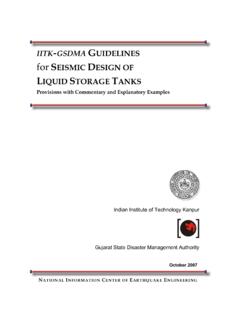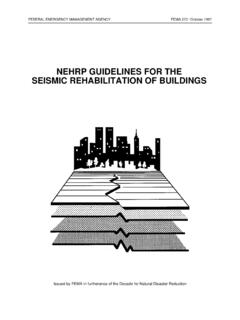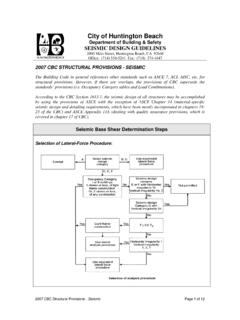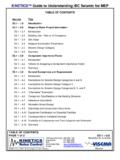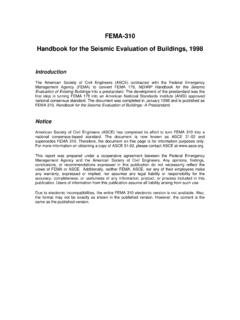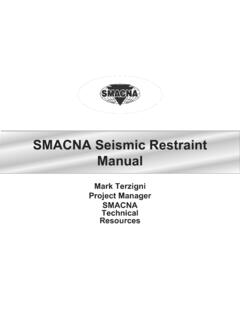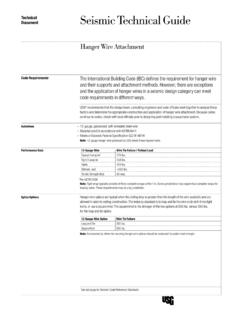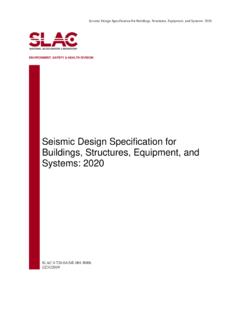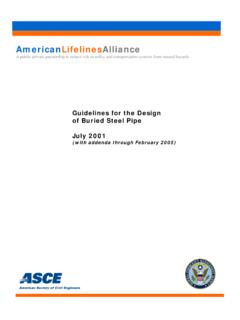Transcription of Seismic Construction Handbook - Sound Concepts
1 SeismicConstructionHandbook2 CISCA | Seismic Construction Handbook Seismic Construction HandbookScopeThis document is intended to help the reader under-stand the Seismic Construction requirements for lay-in, suspended ceilings. It explains those requirements and demonstrates generally accepted Construction methods that comply with these requirements. It also includes a comprehensive list of documents containing these require-ments. It will list what suspended ceiling systems are covered by the IBC/ASCE 7 prescriptive requirements and which are not. Finally, it will give tips to reduce construc-tion costs and suggestions to solve commonly encoun-tered CodesMost people are aware that nearly all Construction in the United States is governed by building codes. Most building code requirements arise from two con-cerns: Life Safety and Aesthetics.
2 Examples of life safety concerns are fire safety, earthquake, wind and structural requirements. Examples of aesthetic concerns are fenc-ing and usage codes (commercial, industrial, residential), as well as signage requirements. It is important to under-stand that most codes are written after the fact. That is, life safety codes are written or updated after a failure. Aesthetic codes are written or updated after residents complain to local government. Although code require-ments seem arbitrary, they are almost always rooted in past problems. Anyone from California or Florida is famil-iar with changes in code requirements after natural disas-ters like earthquakes or prioritization, that is, which document controls the Construction in question, is likewise poorly under-stood. The IBC and ASCE 7 are described as model codes.
3 They do not have the force of law unless adopted by governments. In most states this occurs at the state level. The state code is then adopted by local jurisdic-tion. Some states do not have a state-level building code so all adoption is at the local level. Both the state and local jurisdictions can and do make changes to the codes. Thus, the only way to know the exact requirements is to know what is required by the governmental agency having jurisdiction. Additionally, many states have sepa-rate bodies responsible for schools, hospitals, prisons, state-owned Construction , etc. It is the responsibility of the design professional of record to determine the actual requirements for each Construction of several agencies adopting other stan-dards as part of their own, the prioritization for Seismic Construction of suspended ceilings is particularly complex.
4 The hierarchy from lowest to highest is as follows: ASTM E580 ASCE 7 (which adopts ASTM E580 for most of its Seismic requirements for suspended ceilings) IBC (which adopts ASCE 7 for nearly all Seismic requirements) State Building Code Local Jurisdiction (city, county, township, or state agency such as (OSHPD))The local jurisdiction has the final say for all code requirements. Thus, the City of Los Angeles has require-ments different from the state of California and the state of Oregon has different requirements from the IBC. It is generally only possible to know all the requirements at the local level by doing business in that this priority may seem backwards, it is actu-ally the most practical way of administering code enforce-ment. The model codes cannot possibly anticipate the requirements of every jurisdiction.
5 Jurisdictions with unique natural hazards, such as Florida (hurricanes) or Hawaii (active volcanoes), will be much more qualified to make specific code requirements for these conditions. Agencies responsible for specialized use Construction , such as OSHPD (hospitals), will have a better understand-ing of the requirements of these facilities. Furthermore, Construction details often make compliance with specific code requirements impractical. Local officials and inspec-tors need the authority to approve alternate Construction details to avoid needlessly costly prescriptive requirements in ASCE 7 are intended to cover direct-hung acoustical panel and lay-in panel ceiling following suspended ceilings are exempted from the suspended ceiling requirements of the ASCE 7 as defined by ASTM E580. Screw or nail attached gypsum board ceilings of one level, surrounded by walls that connect to the building structureIntroduction CIS CISCA | Seismic Construction Handbook 3 Ceilings less than 144 square feet ( m2) that are surrounded by walls that connect to the structure above.
6 Island ceilings (suspended from chains ASTM E580) The following ceilings require custom solutions as they are not exempt, but cannot be constructed by using the prescribed Construction method. Indirect-Hung Ceilings Curved Ceilings Lath and Plaster CeilingsChanges in suspended ceiling systems ASCE 7-10 from ASCE 7-05 ASTM E580 is specified in ASCE 7-10 instead of the two previous CISCA Standards Much of the specification in ASCE 7-05 has been eliminated as it is also contained in ASTM E580 These two changes make determining the requirements much simpler, as virtually all requirements are contained in E580, instead of spread out over ASCE 7 and two CISCA documents When dividing a very large ceiling into 2,500 square feet (230 m2) such as using Seismic separation joints or other means, the aspect ratio is now limited.
7 The ratio of the longest dimension to the shortest must be less than or equal to four Power actuated fasteners are now permitted to be used for loads not greater than 90 lbs. (400 N) in concrete and not greater than 250 lbs. (1000 N) in steel. This makes them suitable for suspension wires, but not for lateral bracing. Lateral bracing connections must be capable of holding at least 250 lbs. (1000 N). This is the equivalent of the 180 pound (800 N.) connection force at 45 degrees. Lath and Plaster ceilings are no longer exempt and will require custom solutionsSeismic design CategoryThe requirements for a suspended ceiling are determined by the buildings Seismic design Category. Determination of the Seismic design Category is complex and must be determined by a Registered Architect or Professional Engineer and should be found in the Construction docu-mentation.
8 The Seismic design Category is determined from thefollowing parameters: The design force of the earthquake, which is determined by the location of the building with relationship to known earthquake faults The soil the building foundation rests on The Occupancy Category (use of the building) Seismic design Categories are given letter classifications A, B, C, D, E, and F. The following table lists the require-ments for suspended A & B No RequirementsCategory C Island Ceilings Described in Seismic design Category CCategories D, E, & F Braced Ceiling Described in Seismic design Category D, E, & F Introduction44 CISCA | Seismic Construction Handbook Seismic design Category C design IntentDamage has been observed in mod-erate earthquakes to suspended acoustical tile ceilings.
9 Failure typically occurs at the perimeter of the ceil-ing. Unbraced ceilings are significantly more flexible than the floors or roofs to which they are attached. The ceil-ings therefore will sway independent from the floor or roof, typically result-ing in the runners at the walls breaking their connections. This Construction method is designed to avoid this type of damage when the anticipated earth-quake movements are small. The ceil-ing is isolated from the perimeter so no forces will be transferred from the walls to the suspended ceiling. Thus, the building is free to move without contacting the ceiling. The vertical hanger wires will transfer very little force or movement from the support-ing structure to the suspended ceiling. Thus, the ceiling will not experience any significant forces. For this method to function, no other attachments that may transfer force to the ceiling can be made.
10 Structural components such as columns must be isolated from the suspended ceiling similar to the sur-rounding walls. Other non-structural components such as ceiling-height partitions, sprinklers, etc., must also be isolated from the suspended 7-10. Section or Heavy Duty Load Rating grid as defined by ASTM C635 Minimum main runner splices and cross runner intersections strength of 60 lbs. (270 N) Vertical hanger wires must be a minimum No. 12 gageVertical hanger wires maximum 4 feet (1200 mm.) on center unless justified by calculations or test resultsFor field tied connections, vertical hanger wires must be sharply bent and wrapped with three turns in 3 inches (75 mm) or less (Figure 1) All vertical hanger wires may not be more than 1/6 out of plumb without having additional wires counter splayedWires may not attach to or bend around interfering equipment.
